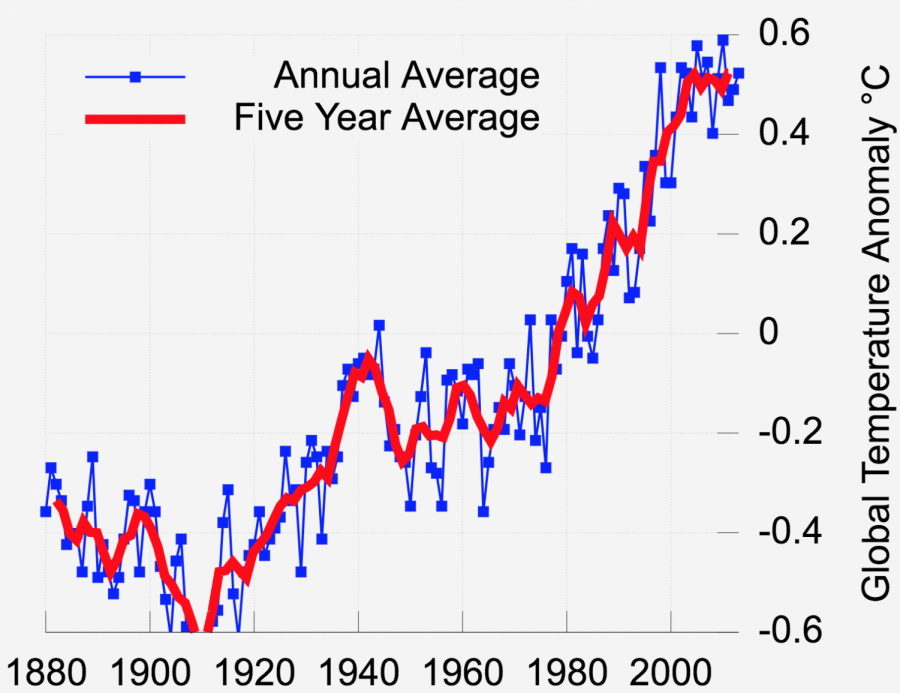World-wide climate initiatives provide hope for environment
Photo used with permission from Google Commons
The average global temperature anomaly continues to rise significantly.
The Paris Climate Agreement, adopted in 2015, aims to keep the global climate from rising above 2.0°C, with the goal of not surpassing 1.5°C, compared to the pre-industrial level. 2020 saw 1.15°C above the pre-industrial level. The world now plans to fight back.
2020 is predicted to have been one of the three warmest years on record. This seemingly small increase in temperature has tremendous impacts, including melting polar ice caps, rising sea levels and increased storm intensity. According to the World Meteorological Organization, “Arctic sea ice for July and October 2020 was the lowest on record… and ocean heat content for 2019 was highest on record in the datasets going back to 1960.”
The effects of global warming not only threaten the environment and other species, but the livelihood of humans as well. Higher sea levels can displace millions of people living in coastline cities and more hurricanes, floods and wildfires can make parts of the world uninhabitable. Warmer atmospheric temperatures worsen air quality, which is dangerous to humans’ health.
World leaders, now agreeing they need to battle climate change, have begun to implement combative measures. The Climate Adaptation Summit on Jan. 25 and 26 allows leaders from around the world to discuss how to alleviate the impacts of climate change by developing concrete strategies and forming new partnerships. Under the United Nations Sustainable Development Goal 13, the countries of the world aim to educate citizens on global warming and its impacts, develop strategies to adapt to climate-related disasters and support less developed countries in climate policies. Goal 13 also has a target of “mobilizing jointly $100 billion annually by 2020 from all sources to address the needs of developing countries… on implementation and fully operationalize the Green Climate Fund through its capitalization as soon as possible,” according to the United Nations.
The most impactful world-wide climate initiative, the Paris Climate Agreement, is the first time nearly every nation in the world has worked together to protect the environment. Under the Paris Agreement, nations are set to meet every five years to submit their climate plans, called nationally determined contributions (NDCs). This is meant to ensure the nations stay on track in reducing greenhouse gas emissions and adapting to higher temperatures.
The first time countries were supposed to meet to share these NDCs was in November 2020. However, the meeting has been delayed to November 2021 due to Covid-19. The agreement also encourages countries to support each other financially, technologically and in capacity-building. Countries are also required to report their actions taken and their progress made every four years under the enhanced transparency framework (ETF).
Under the Paris Climate Agreement, “More and more countries, regions, cities and companies are establishing carbon neutrality targets. Zero-carbon solutions are becoming competitive across economic sectors representing 25% of emissions,” according to the United Nations Framework Convention on Climate Change.
Counties in the European Union, Japan and South Korea, along with roughly 105 other countries, have set a net-zero target to be achieved by mid-century. More specifically, at the UN General Assembly in September, “ Chinese President, Xi Jinping announced that China aimed to go carbon neutral by 2060,” according to BBC News.
Within President Joe Biden’s first few days in office, he has already signed executive orders for the United States to rejoin the Paris Climate Agreement, after former President Donald Trump announced he was pulling out in 2017, and has revoked the Keystone XL Pipeline permit. Biden’s climate plan states that he will integrate climate change initiatives into his plans for foreign policy, trade and national security. He also plans to protect communities that will be affected by transitioning to more sustainable living practices and he will protect communities that are more vulnerable to pollutants, such as Flint, MI.
Overall, Biden will create the “largest-ever investment in clean energy and research,” spending over $400 billion in climate initiatives over 10 years, as he puts the country on track to “achieve a 100% clean energy economy and reach net-zero emissions no later than 2050,” according to joebiden.com.
Your donation will support the student journalists of Thomas S. Wootton High School. Your contribution will allow us to purchase equipment and cover our annual website hosting costs.
Quinn Lugenbeel is a 2021 graduate.








